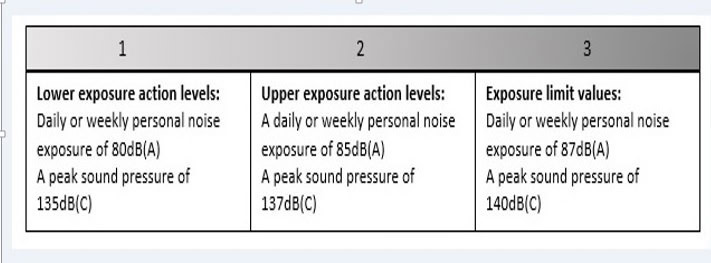To most people, 80, 85 and 87 decibels may not mean much but, to a manager with health and safety responsibilities and operating under the Control of Noise at Work Regulations, it means taking specific action in the workplace to ensure that they prevent or reduce risks from exposure to noise to the lowest level reasonably practicable. These three values matter because they form part of Regulation 6 of the UK’s Control of Noise at Work Regulations (2005) and any breach may lead to an employee suing for personal injury. There is still considerable concern over the increasing cases of occupational deafness which explains why we have covered this subject so often in the last year. We wanted to share with you the main action points behind those values again.
80, 85 and 87 decibels – where do these values come from?
The noise Regulations are part of the Health and Safety at Work Act 1974 which derives from European legislation. It is legally binding and each of the 28 EU member states must incorporate it into their national law. So most of you will be familiar with them already.
The Regulations in the UK refer to ‘exposure action level values’ and ‘exposure limit values’.
What is an action level value or exposure limit value?
An action level is basically a noise exposure level at which employers are required to take certain steps to reduce the harmful effects of noise on hearing. There are two main action levels for continuous noise, 80 decibels and 85dB(A):
- The lower exposure action value is a daily or weekly average noise exposure level of 80 decibels (dB(A)), at which the employer has to provide information and training and make hearing protection available. Download our FREE GUIDE to selecting the correct hearing protection here
- The upper exposure action value is set at a daily or weekly average noise exposure of 85dB(A), above which the employer is required to take reasonably practicable measures to reduce noise exposure, such as engineering controls or other technical measures. The use of hearing protection is also mandatory if the noise cannot be controlled by these measures, or while these measures are being planned or carried out.
- Finally, there is an exposure limit value of 87dB(A), above which no worker can be exposed (taking hearing protection into account).
80, 85 and 87 decibels – why these values matter:

The Regulations also refer to peak exposure action and limit values.
These are defined because high-level peak noise can lead to short term and long term hearing loss. Impulse noises such as cartridge tools, hammers and borehole equipment can all produce high peak sound pressures.
If the daily noise exposure exceeds the lower exposure action level 80dB(A), then a noise assessment should be carried out and recorded by a competent person.
What if the noise levels vary during the week?
If there is a strong variation in noise exposure levels during the working week, then the Regulations allow a weekly rather than daily exposure level LEP,w to be used. It is only likely to be significantly different to the daily exposure level if exposure on one or two days in the working week is 5dB(A) higher than on the other days or the working week has three or fewer days of exposure.
If a business is considering the use of a weekly exposure level, then the following applies:
- Hearing protection to be made available
- Employees and their representatives must be consulted on the method of monitoring
- Effects on employees of this type of monitoring must be communicated and explained
Lastly, if the working day is 12 hours – which is quite common nowadays – then the action levels must be reduced by 3dB(A) because the action levels assume an 8-hour working day.
Remember: the noise in a work environment is measured using a sound level meter or personal sound exposure meter, which reads sound pressure levels in dB(A) and the peak sound pressure we refer to in this post. Modern noise measurement devices can provide you with the values described above simultaneously.
Find out more about the Noise at Work Regulations.